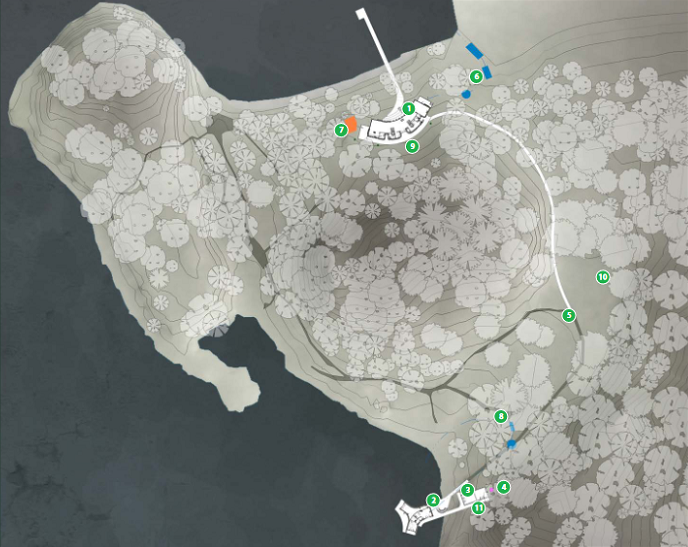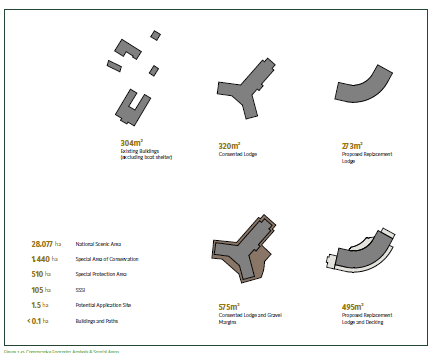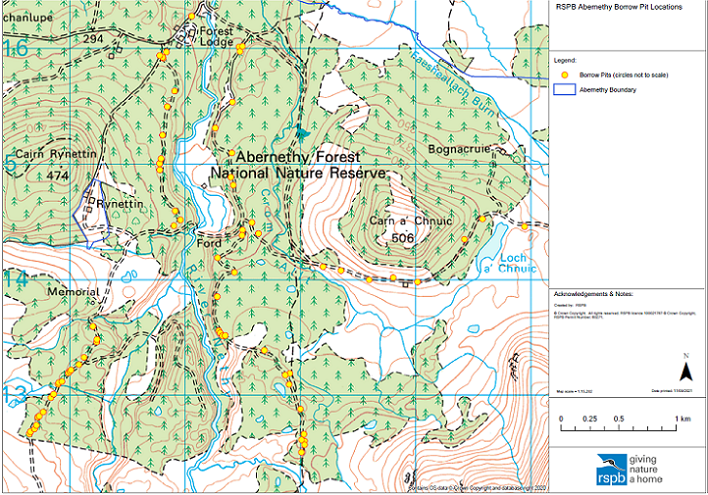Inchconnachan, the Loch Lomond island, has been in news recently because of the proposals to get rid of its wallabies. This is linked to the planning application (see here) that has been submitted by the new owners, Kirsty Young and her husband Nick Jones, to develop luxury tourist accommodation on the island, part of the Loch Lomond oakwoods Special Area of Conservation (SAC).
I will take a look the wider implications and merits of those plans in a further post. Here I consider the application within the context of recent approaches that have been taken by our National Park Authorities towards the protection of SACs, supposedly Scotland’s most highly protected sites.
The Roderick Dhu footpath at Trossachs Pier
In October last year I wrote (see here) about how the Loch Lomond and Trossachs National Park Authority (LLTNPA) planners had recommended that the planning application to create 188m of path to the “Roderick Dhu” viewpoint be rejected because it would have:
“an adverse effect on the integrity of the Trossachs Woods SAC. The proposal will lead to lasting and irreparable loss to a part of the SAC. While relatively small scale in terms of the physical footprint of development, relatively small scale losses of habitat can adversely affect the sites integrity”.
The area of ground that the planners estimated would be affected was 367 square metres or 0.097% of the SAC. The LLTNPA planners maintained this assessment even after NatureScot, the lead public authority responsible for SACs, flipped its view and decided the path would not affect the integrity of the site after all. The Ferret later revealed that NatureScot’s 180° about-turn followed the intervention of their chair Mike Cantlay (see here). In my view this was the right decision, but made in the wrong way. It has left NatureScot without any apparent consistent set of principles by which it might assess the impact of proposed developments on SACs.
The Inchconnachan Planning Application and the Loch Lomond Oakwoods SAC

, The Planning Application contains a number of elements, most are on parts of the SAC that have been “untouched” up till now. The applicants have tried to minimise the impact of this by comparing the footprint of the proposals to the area of the old lodge and the area around it, which the LLTNPA had agreed could be redeveloped back in 2012 and then again in 2018 (see here):

By comparing the footprint of the new development with the footprint of the development that has been consented, it is made to look smaller and therefore more acceptable. This is not, however, comparing like with like: the previous planning consents concerned a new lodge on land that had previously been developed (area 10 on the map above) whereas the current proposal will impact on a so far undeveloped area of that SAC. It therefore has NEW implications for the integrity of the site.
The Planning Application tries to address this problem by arguing that most of the development will not affect “the qualifying features” of the site and that the proposed development is on part of the SAC that doesn’t really matter. I made similar arguments in my post on the Roderick Dhu footpath which will affect birch woodland, not oak. .
The LLTNPA planners, however, rejected those arguments for the Roderick Dhu footpath claiming that ANY development would affect the integrity of the SAC. If the LLTNPA planners were being consistent, therefore, they should have told the applicants that in their view any development in a new area of the SAC would affect the integrity of the protected area.
The Inchconnachan Planning Application states that the site area – i.e all the ground that could be affected by the development and its construction – is 1.4 hectares or four times more than the area that would be affected by the Roderick Dhu path. The exact length of the new path is not given but my reckoning it is 120m long and the plans show it is 1.5m wide, i.e will affect an area of 180 square metres. Even if the construction corridor is only 1m on either side that will affect 420 square metres of the SAC compared to the 367 square metres of the Roderick Dhu path. The applicants argue that because they have created the path in the form of a board walk the impact will not be so great. However, the vegetation under the board walk will inevitably change in its shadow, while posts driven into the ground will impact the soil (a concern of the planners in the Roderick Dhu case).
The Loch Lomond Oakwoods SAC covers 1440 hectares, so this 1.4 ha development will affect 0.1% of the SAC. Not a lot maybe, but more than the 0.097 of the Trossachs SAC which prompted the LLTNPA planners to reject the Roderick Dhu path.
The planning application for the Roderick Dhu path was submitted by the Steamship Trust on 9th October 2020 and, following, that hurdle after hurdle was placed in their way first by NatureScot and then the LLTNPA before the Planning Committee in August last year overturned officers’ recommendations. The Inchconnachan Planning Application shows that during this same period LLTNPA officers were engaging with the team behind the development there, starting with a meeting at the top – with Stuart Mearns the Director of Planning – on 20th November 2020:

According to the Planning Application form Stuart Mearns at the first meeting (he was the ONLY member of staff from the LLTNPA present) “encouraged design-led approach and early engagement with planning authority” – there is no mention of the constraints imposed by the existence of the SAC. The meeting noted a case officer had been already been allocated and the applicants met with him later the same day.
At the third meeting on 29th January the application records “Advice given on designated nature of the Island. Comprehensive, design-led approach welcomed. Advice given on scope and level of detailed expected in the pre-application submission. LLTNPA highlighted key issues to consider”. Again there is no record of the SAC or the constraints that imposed.
The impression from all of this is that the LLTNPA were bending over to help the applicants in the Inchconnachan case at the very time they were throwing obstacles in the way of a footpath at Trossachs Pier. If LLTNPA Officers recommend the Inchconnachan development goes ahead, I will look forward to reading their explanation of why they appear to have taken such a different approach in the two cases.
Luckily for the Director of Planning the LLTNPA Planning Committee overturned his recommendation in the case of the Roderick Dhu path by a majority vote. This leaves it open for the Committee to adopt a consistent position and argue that since in both cases only about 0.1% of the SAC will be affected neither should be seen as affecting its integrity.
However, in terms of the protection of the SAC, that would still leave questions about whether the proposals in the Inchconnachan application are unnecessarily damaging. For example, 222 square metres out of the 495 square metre total footprint of the new lodge comprises decking. A footpath in a SAC is one thing, decking I would suggest is another. It be interesting to see how both NatureScot and the LLTNPA respond to that one.
Abernethy
For comparative purposes, it’s worth considering a recent planning application in the Cairngorms National Park. In September the RSPB submitted a full planning application to create up to 71 borrow pits to repair forest tracks in the Abernethy National Nature Reserve (see here). The entire area covered by the application lies within the Cairngorms SAC, designated to protect woodland habitats, in this instance Caledonian Pine Forest.

The borrow pits are small, up to 2m x 2m x 2m, a total of 284 square metres but the area of the SAC which will be affected may be significantly greater than that, with borrow pits being located up to 10m from the track (requiring excavators to cross protected ground) while “the sides of each hole will be re-graded (pulled in slightly) to make a smooth dip as opposed to sharp steep sides”. In short, the amount of ground affected appears significantly more extensive than at the Roderick Dhu.
Moreover, the borrow pits once restored will leave holes/dips in the landscape as a result of material being extracted which will inevitably affect drainage and vegetation cover. So how did our Public Authorities respond?
The Cairngorms National Park Authority (CNPA) decided that the impact on the SAC was so unimportant that they would not call-in the planning application but leave the decision to Highland Council. The CNPA’s ecology officer noted the the borrow pits were unlikely to result in any significant adverse impacts on any species or habitats if works are undertaken according to the “Method Statement”.
The response from NatureScot is not on the planning portal but there is a summary of it in Highland Council’s report of handling:
 There is no mention here of the “integrity” of the SAC, which was such an important feature of NatureScot’s initial objection to the Roderick Dhu footpath. It will be interesting to see if the CNPA and NatureScot take a similar laid-back approach to future proposals to repair or develop footpaths within SACs in the Cairngorms.
There is no mention here of the “integrity” of the SAC, which was such an important feature of NatureScot’s initial objection to the Roderick Dhu footpath. It will be interesting to see if the CNPA and NatureScot take a similar laid-back approach to future proposals to repair or develop footpaths within SACs in the Cairngorms.
The planning system and SACs
These three planning applications tell us that our Public Authorities are all over the place when in comes to considering the impact of developments on SACs and there is no consistency in how decisions are taken. That should be a cause of public concern, a concern to the Boards of NatureScot and our two National Park Authorities and a concern to the Scottish Government.
It is difficult to avoid the conclusion that senior management in our public authorities are applying one set of rules to development in SACs that are for land-management and commercial purposes, and another to developments that are intended to facilitate public enjoyment of those areas. That would be consistent with the different approaches that our two National Park Authorities take to land-owners and businesses compared to ordinary people wanting to get out into the countryside: fires lit by campers are stamped on while muirburn continues to be tolerated; walkers are told to keep to the path (particularly in areas like SACs) while land-managers are allowed to drive All Terrain Vehicles willy nilly all over the countryside. It’s time the Scottish Government, which professes an interest in fairness and combating discrimination, took a look at what is going on in our National Parks.

Within an SAC the only thing that should happen is the conservation management of the SAC, unless, under special circumstances, the proposal is of national importance. If there is land within the SAC that is not in favourable condition, there is a duty to reverse this situation. As the wallabies are not part of the natural ecosystem there should be a presumption that they are removed.
If there are existing developments on the island then they should have been excluded from the SAC when it was classified. If they were not, then it is the duty of the planning authority to remove planning consent and enable the restoration of the conservation interests. At the time the SAC was classified, the planning authorities had a statutory duty to review all planning consents within and adjacent to the site.
The wallabies have been there for the best part of a century and have done no harm to anyone. The obsession in certain quarters with destroying anything which doesn’t conform to an arbitrary definition of “indigenous species” is pure control freakery.
If the choice for Inchconnachan is between a private development for the very rich elite or a “conservation zone” containing only approved species of flora and fauna, either way the losers are the ordinary public who have used it for years for recreation with no substantial impact on it who will be excluded either way.
What we have here is the future for Loch Lomond and indeed all of the countryside, excluded to all but the rich for “conservation” reasons, for the rest we get to watch it on TV programmes made by the same elite for which they are paid huge sums.
The Wallabie are a golden opportunity for tourists and locals businesses coming from Luss and Balmaha their is also the science point to look at Their has been a lot of in breeding so a great opportunity for scientific research but again Scotland backward and inward looking is to destroy Surely if a species that has survived on a island even if not indigenous should their not be a argument to save them and study them they have lived their for 40 years at one point their was 60 now down to 8 as the Luss estate had them shot At the moment the purists are trying to remove the ring neck parakeets from Glasgow to save starlings 30 years ago they removed starlings also if you trap them they will have to be killed as the law stands correct me if wrong they can’t be released
A huge threat to the public enjoyment of the National Park are Security/Deer Fences. It appears possible to erect a 6ft fence of coated (green) mesh with a couple of security gates without any sort of permission. This has happened at Ardlui, looks awful and makes the landscape officer’s report to planning, which allowed the self catering complex, a total nonsense. The same could happen on Inchconnachan and there appears to be nothing could be done about it after planning permission has been given. For example what happens if the whole, or even the northern half of the island is enclosed and claimed to be the “domain” of the new house. As an absolute minimum there should be a “no fencing” condition to approval to allow people to continue to walk over the island (hunting for sight of the wallabies!)
That is exactly what will happen. Very quickly after the access law came into force the courts ruled that the amount of land you are entitled to exclude the public from for “privacy” is dependant on how rich you are.
With Sarah Smith recently bleating publicly about how she doesn’t feel safe in Scotland, in the unlikely event of LLTPA as the access authority opposing restrictions on Inchconnachan expect the “security” card to be played.
How are Kirsty and husband and guests going to access the island? Seaplane, powerboat, RIB. Off to Cameron House for dinner then back. The wallabies have squatters’ rights and won’t be happy with all the noise.